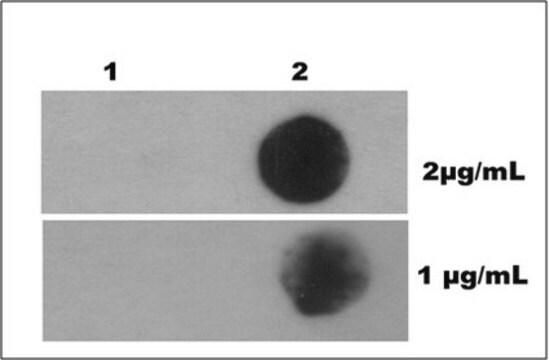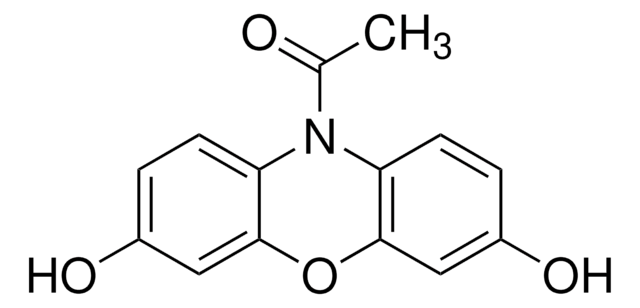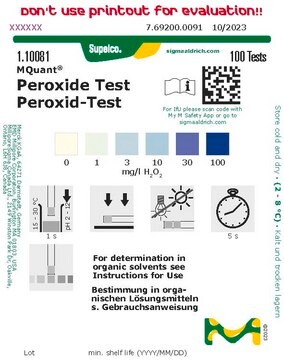MAK165
Fluorimetric Hydrogen Peroxide Assay Kit
sufficient for 500 fluorometric tests (red fluorescence)
Sinónimos:
Hydrogen Peroxide Quantification Kit
Iniciar sesiónpara Ver la Fijación de precios por contrato y de la organización
About This Item
UNSPSC Code:
12161503
NACRES:
NA.84
Productos recomendados
usage
sufficient for 500 fluorometric tests (red fluorescence)
detection method
fluorometric
relevant disease(s)
cardiovascular diseases; aging/geriatric diseases; orthopedic diseases; pulmonary disorders; neurological disorders
storage temp.
−20°C
Categorías relacionadas
General description
Hydrogen peroxide, a reactive oxygen species produced through the metabolism of molecular oxygen, serves as both an intracellular signaling messenger and a source of oxidative stress. Hydrogen peroxide is generated in cells via multiple mechanisms such as the NOX-mediated ROS production by neutrophils and macrophages (respiratory burst) or by the dismutase of superoxide anions produced as a result of electron leak during mitochondrial respiration. Abnormal hydrogen peroxide production contributes to oxidative cell damage and the progression of diseases such as asthma, atherosclerosis, osteoporosis, and neurodegeneration.
Features and Benefits
Compatible with high-throughput handling systems.
Suitability
This kit is suitable to quantify hydrogen peroxide levels in a variety of samples such as cellular extracts and solutions.
Principle
The Fluorescent Hydrogen Peroxide Assay Kit provides a simple and reproducible method to quantify hydrogen peroxide levels in a variety of samples such as cellular extracts and solutions. This kit can also be used to detect hydrogen peroxide released from living cells or produced by oxidase activities. This kit utilizes a peroxidase substrate that generates a red fluorescent product (λex = 540/λem = 590 nm) after reaction with hydrogen peroxide that can be analyzed by a fluorescent microplate reader.
signalword
Danger
hcodes
Hazard Classifications
Acute Tox. 4 Oral - Resp. Sens. 1
Storage Class
10 - Combustible liquids
flash_point_f
Not applicable
flash_point_c
Not applicable
Elija entre una de las versiones más recientes:
¿Ya tiene este producto?
Encuentre la documentación para los productos que ha comprado recientemente en la Biblioteca de documentos.
Los clientes también vieron
Foteini Vasilopoulou et al.
GeroScience, 43(2), 965-983 (2020-11-01)
Brain aging and dementia are current problems that must be solved. The levels of imidazoline 2 receptors (I2-IRs) are increased in the brain in Alzheimer's disease (AD) and other neurodegenerative diseases. We tested the action of the specific and selective
Wei Zhu et al.
Oxidative medicine and cellular longevity, 2019, 5305014-5305014 (2019-06-11)
Females develop kidney stones less frequently than males do. However, it is unclear if this gender difference is related to altered estrogen/estrogen receptor (ER) signaling. Here, we found that ER beta (ERβ) signals could suppress hepatic oxalate biosynthesis via transcriptional
Yan Zhang et al.
Journal of nanobiotechnology, 19(1), 161-161 (2021-06-02)
As one typical cardiovascular disease, atherosclerosis severely endanger people' life and cause burden to people health and mentality. It has been extensively accepted that oxidative stress and inflammation closely correlate with the evolution of atherosclerotic plaques, and they directly participate
Abraham Lin et al.
Oxidative medicine and cellular longevity, 2020, 9750206-9750206 (2020-12-22)
Non-thermal plasma (NTP), an ionized gas generated at ambient pressure and temperature, has been an emerging technology for medical applications. Through controlled delivery of reactive oxygen and nitrogen species (ROS/RNS), NTP can elicit hormetic cellular responses, thus stimulating broad therapeutic
Rakesh Ruchel Khanikar et al.
RSC advances, 12(15), 9466-9472 (2022-04-16)
Cold atmospheric pressure (CAP) plasma has a profound effect on protein-protein interactions. In this work, we have highlighted the deactivation of the Severe Acute Respiratory Syndrome Coronavirus 2 (SARS-CoV-2) spike protein by CAP plasma treatment. Complete deactivation of spike protein
Nuestro equipo de científicos tiene experiencia en todas las áreas de investigación: Ciencias de la vida, Ciencia de los materiales, Síntesis química, Cromatografía, Analítica y muchas otras.
Póngase en contacto con el Servicio técnico







